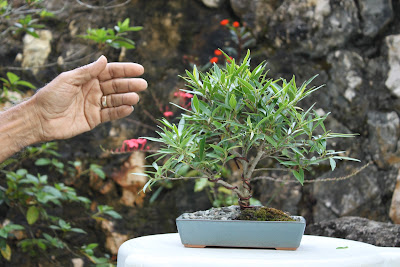Beautiful BONSAI
Labour of boundless patience, care and love
"Discipline is rooted in Japanese society," says Kaori Saito, cultural officer at the Embassy of Japan in Jamaica. "You follow rules, concentrate on what you do and communicate often with yourself."
 Saito's words capture the essence of bonsai, an ancient Japanese art form taking root in Jamaica - figuratively and literally.
Saito's words capture the essence of bonsai, an ancient Japanese art form taking root in Jamaica - figuratively and literally.
For Derizzio, a former banker and past president of the Jamaica Horticultural Society, seeds of bonsai - which literally means plantings in a tray (bon: tray-like pot; sai - plantings) - began germinating in his mind. He has since been meticulously trimming, replanting, and giving shape to roots and leaves.
Parke's earliest memories of bonsai are from the calendars his father got from a trip to Japan. "I had always maintained a lingering interest in bonsai but was never able to act on it because of the dearth of bonsai practitioners in Jamaica - or so I thought," he said.
Parke met Derizzio and other bonsai enthusiasts three years ago and began his bonsai journey.
The process, both bonsai practitioners point out, requires a combination of artistic and horticultural principles.
"The artistic principles," he adds, "are similar to those applicable to painting, or sculpture, such as proportion, focal point, etc."
"Training a bonsai is not back-breaking, but could be termed as painstaking, and requires the enthusiast to demonstrate patience as the tree develops," explains Parke.
 Plant husbandry is necessary to maintain the health of bonsai, they say, which, unlike other trees or plants growing in the ground, are restricted by the limited resources of its pot and the soil.
Plant husbandry is necessary to maintain the health of bonsai, they say, which, unlike other trees or plants growing in the ground, are restricted by the limited resources of its pot and the soil.
"Good knowledge of the requirements of the particular plant species being trained is also necessary to ensure the survival of the bonsai," says Parke, an attorney-at-law and a third-generation farmer.
The bonsai enthusiast "must first of all be a plant and nature lover and be prepared to exercise a lot of patience," Derizzio says as he arranges a buttonwood bonsai that he has been nurturing for 15 years, and which is an evolving work in progress. "Having an imagination or being able to envision the tree in its future form is also a skill which can be developed with time," adds Parke. Trees that are ideal for training as bonsai are those with small leaves or those that adapt well to reduction in leaf size, Derizzio says. Some of the native species which bonsai practitioners use include Acerola cherry, Suriname cherry, buttonwood, lignum vitae, logwood, poinciana, yellow poui, ebony, and black olive.
Trees that are ideal for training as bonsai are those with small leaves or those that adapt well to reduction in leaf size, Derizzio says. Some of the native species which bonsai practitioners use include Acerola cherry, Suriname cherry, buttonwood, lignum vitae, logwood, poinciana, yellow poui, ebony, and black olive.
To train a bonsai plant, a meticulous strategy is followed. The leaves are clipped several times in the year to curb their growth, stems are tied with wire to wean them in the desired direction and shape that the practitioner envisages. Replanting, pruning the stem, branches and roots periodically are part of the cultivation process.
Bonsai, according to Parke, has a calming influence, which fosters an appreciation for the more positive elements of human life and existence.
Characteristics involved in this evolving piece of living art emanate from the way of life in the Land of the Rising Sun. "We (Japanese people) develop appreciation for life and nature," says Hiromoto Oyama, first secretary at the Embassy of Japan in Jamaica.
"Like the flow of the water in the river, or the cherry blossom which just blooms for a week, it reminds us that life evolves, and we need to be thankful for that moment," Oyama says.
amitabh.sharma@hotmail.com
Published March 3, 2013 - The Sunday Gleaner








Comments
Post a Comment